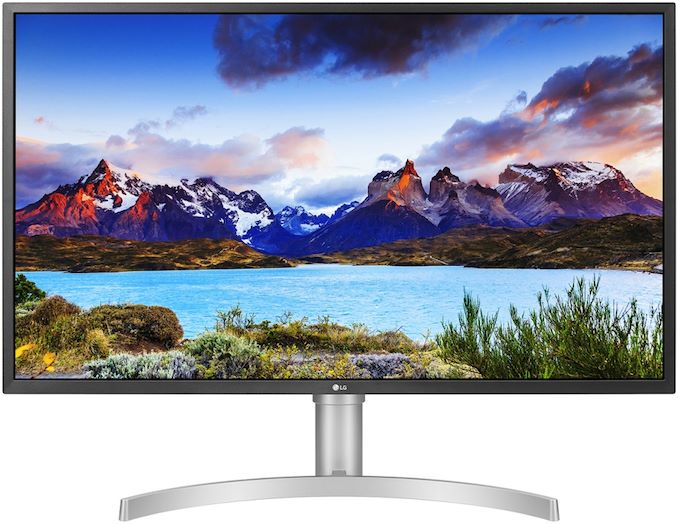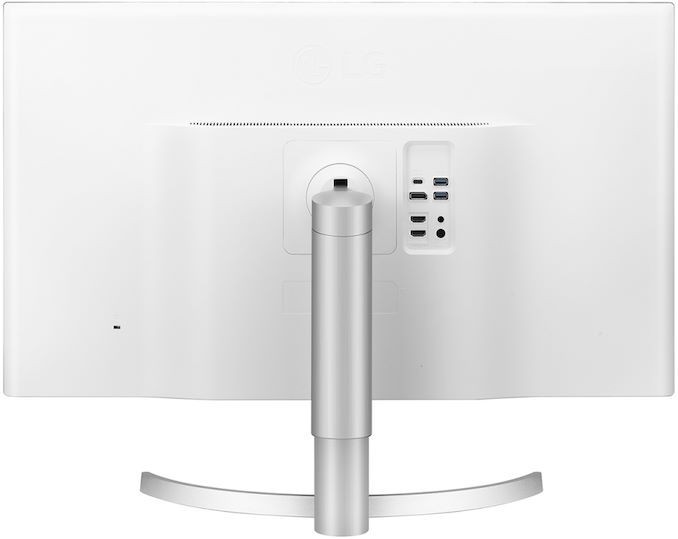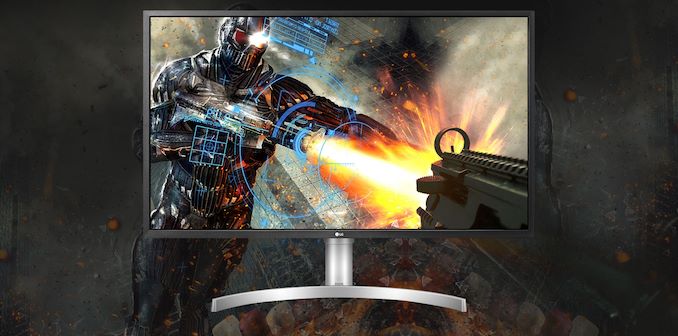LG Launches Midrange 32UL750-W Monitor: DisplayHDR 600 with FreeSync & USB-C For $750
by Anton Shilov on February 4, 2019 11:00 AM EST
In the recent years LG has introduced a number of high-end Ultra-HD 31.5-inch displays, many of which have received a lot of publicity due of their features and innovative technologies. As of late, the company has also expanded into midrange and entry-level segments with its 31.5-inch monitors. And to that end, this week LG has begun selling its 32UL750-W Ultra-HD LCD, a midrange 4K display for customers who want something better than the company's mainstream offerings, but are not ready to invest in a high-end model.
The LG 32UL750-W is based on a 31.5-inch VA panel that offers a 3840×2160 resolution, 400 nits typical brightness, a 3000:1 contrast ratio, 178° viewing angles, a 60 Hz refresh rate (with FreeSync), and a 4 ms response time. The DisplayHDR 600 badge that the monitor carries obviously points to 600 nits peak brightness along with HDR10 processing capabilities, but LG is not publishing any information about local dimming and LUTs (look-up-tables) for HDR. Meanwhile the panel can reproduce 1.07 billion colors and covers 95% of the DCI-P3 color space (and should be able to hit 100% of the sRGB color gamut).
To make the monitor more attractive for the target audience, the 32UL750-W display comes factory calibrated and supports a number of features designed for gamers, including LG’s Black Stabilizer (makes dark scenes brighter) and Dynamic Action Sync (minimizes input lag), as well as AMD's FreeSync already mentioned before.
Connectivity is another strong selling point of the 32UL750-W. The monitor has a DisplayPort 1.2 input, two HDMI 2.0b ports, as well as one USB Type-C connector. The latter supports up to 60 W power delivery, so it can help to power many modern laptops. As for audio, the display has two 5 W speakers and a headphone output. As an added bonus, it also features a dual-port USB 3.0 hub.
| Specifications of the LG 32UL750-W Display | |
| 32UL750-W | |
| Panel | 31.5" VA |
| Native Resolution | 3840 × 2160 |
| Maximum Refresh Rate | 60 Hz |
| Response Time | 4 ms |
| Brightness | 400 cd/m² (typical) 600 cd/m² (peak) |
| Contrast | 3000:1 |
| Viewing Angles | 178°/178° horizontal/vertical |
| HDR | HDR10 |
| Dynamic Refresh Rate | AMD FreeSync/VESA Adaptive-Sync (at 40 ~ 60 Hz) |
| Pixel Pitch | 0.1816 mm² |
| Pixel Density | 140 ppi |
| Display Colors | 1.07 billion |
| Color Gamut Support | DCI-P3: 95% sRGB: 100% |
| Stand | Tilt and height adjustable |
| Inputs | 1 × DisplayPort 1.2 2 × HDMI 2.0a 1 × USB-C with 60 W PD HDCP 2.2 |
| USB Hub | Dual-port USB 3.0 hub |
| Audio | 5 W × 2 audio out port |
| Launch Price | $700 ~ $750 |
Looking at LG's broader lineup, the LG 32UL750-W sits right between the company’s range-topping 32UK950/32UL950 Ultra-HD monitors, which use panels with LG’s Nano IPS technology, as well as its more reasonably-priced 32UK550 Ultra-HD display. The high-end 31.5-inch LCDs from LG retail for $1000 ~ $1300, whereas the cheaper 31.5-inch monitor costs around $500. The new 32UL750 will, in turn, cost approximately $749 (SRP) in the US, placing it between the other models in both features and pricing.
LG started to sell its 32UL750-W LCD in Japan this week at a price of ¥76,800 ($705) without tax. That said, expect the display to show up in other countries shortly. Which, keeping in mind that electronics prices in Japan tend to run a bit high by global standards, I wouldn't be surprised to see street prices for the monitor in the US come in below its official $749 MSRP.
Related Reading:














39 Comments
View All Comments
Nfarce - Monday, February 4, 2019 - link
^^Thank you. I'm so tired of whiners complaining about price increases with new tech and advances. You understand the history of monitor pricing. Many do not and think that we'll all pay sub-$300 prices forever in new monitors with higher resolutions and larger sizes.My second monitor was circa 1999 with a 19" Sony Trinitron GS420 with1600x1200 resolution which was at the time today's 2K. I paid $520 for it at the time after tax and shipping, which in today's dollars (USD) translates to about $780. My first monitor was a Dell 17" Trinitron made by Sony (1280x1024 resolution) and came with my $2,200 Dell Pentium II D333 PC ordered in 1998. It was a $240 upgrade from the standard 1024x768 15" CRT it came with by default.
Let's look at that Dell PC price again: in November 1998, I paid $2,200 for it including the monitor upgrade. In today's dollars, that is close to $3,400. People out there complaining about a 32" 4K monitor being priced at $750 are clueless about history and time value of money regarding inflation. To put that into perspective, in 1998, that $750 in today's dollars was right at $500.
I purchased an AOC 32" 2560x1440 (Q3279VWFD8) during a Cyber Monday sale and only paid $175 for it. It currently goes for about $250. A complete steal even at that price considering it's a simulated 10-bit IPS (8-bit+FRC) with 75Ghz FreeSync.
There are so many tech bargains out there these days if you know how to research and shop around. But in this instant gratification society these days driven by fingertip info and social media, those attention-demanding skills of researching are declining.
RSAUser - Monday, February 4, 2019 - link
Your argument fails in terms of economy of scale. Market is substantially different from what it was 20 years ago.Death666Angel - Tuesday, February 5, 2019 - link
"Sorry, but $250 for a 32" 4K monitor is a pipe dream." I have a 31.5" 4k monitor in front of me that cost me 316.50€, which is 266€ without 19% VAT. Considering everything is slightly cheaper in USD, this seems to be squarely in the "$250 for a 32" 4k monitor" region you state is impossible. This wasn't a super deal or anything either.Comparing 2010 30" 1600p prices to this is also not an honest comparison. 30" 2560x1600 16:10 monitors at that point were professional grade aimed at businesses and professional consumers with calibration and wide gamut support. At that point, 16:9 1440p monitors had entered the market and driven down pricing for 1080p+ monitor significantly. I remember 1600p monitors being above 1k consistently with maybe an odd Fujitsu or HP/Dell refurb one being in the 900+ category. But the 1440p monitors, despite only lacking a fraction of the pixels, were significantly cheaper (I bought a top of the line Samsung S27A850D with PLS 1440p panel für 550€ in early 2012). 4k today is nothing like 30" in 2010. That is reserved for the 5k and 8k monitors now.
I can also buy a 31.5" 1440p 75Hz Freesync VA panel monitor for 200€ right now (AOC Q3279VWF). So I don't get why a worse one that is more expensive as the cheap alternative. The only advantage that thing has is that it seems to be 10bit without FRC, vs. my 8bit with FRC.
Eidigean - Tuesday, February 5, 2019 - link
266 euros converts to $303.62 at the moment. With tax it's over $360. We're still not down to the pipe dream of $250. What's model monitor do you have?In my $1,000 three decade scenario, I intentionally picked the best monitor one would realistically want and could get. For me, that's always been a professional monitor with accurate color. Off angle color shift is a deal breaker. For these LG and BenQ monitors in question, I'm not sure if a VA panel can meet my non-gaming needs.
I like the affordability of the 95% DCI-P3 gamut, and actually despise local dimming (something these lack) so I'm leaning toward the BenQ EW3270U for a secondary system with HDR support.
Jad77 - Monday, February 4, 2019 - link
Why can't I find a high-refresh, FHD, 24-inch monitor (ya know, the gaming version of what I use now), that doesn't have the letters TN attached to it? And, 75Hz is not high refresh.lowlymarine - Monday, February 4, 2019 - link
Several companies sell monitors based on Samsung's 24" 1080p VA 144 Hz panel. The main downside is that they typically only have FreeSync ranges of ~90-144 Hz, though at least Nixeus sells one that claims to sport the full 30-144 Hz range. I have an MSI Optix 24G, which honestly I wouldn't recommend since it doesn't really do anything better than the Nixeus and is a little more expensive. Mine has slight brightness flicker if I turn on overdrive or use CRU to extend the FreeSync range at all, but does work flawlessly at its out-of-the-box specs. Just remember that as these are VA panels they aren't going to have response times quite as good as TN displays, no matter the marketing BS of "1 ms" on the box, so there's some slightly increased ghosting compared to a comparable TN monitor.Vishnu NS - Monday, February 4, 2019 - link
I can vouch for the Nexus 27" 1440p 144Hz IPA monitor ! Been using it for nearly a full year now. Works great.imaheadcase - Monday, February 4, 2019 - link
Because they are using the panels for high end monitors. Its not viable to produce such low size monitors for a market that is catered toward cheaper monitors and gamers. I mean look at the 27 inch 144Hz 4k for the example of how much it costs with just gaming features. THey would rather use the size for business/photo/media segment that does not need such features.But honestly, not many people even bother with 24 inch monitors anymore..its mostly 27+ people use. Even then after 120Hz its not really a big deal for most games since it won't even push it that high on a 35 inch.
24inch IPS 200Hz monitor would be eye cancer.
Hxx - Monday, February 4, 2019 - link
60 hz is a real shame for a monitor clearly targeted for casual use which is where i would include gaming. I would get an Acer x34p or the alienware a348dw in a heartbeat over this one for about the same moneybug77 - Tuesday, February 5, 2019 - link
Monitors implementing HDR600 are NOT geared towards casual use. They're definitely not primarily meant for gaming.This is an entry-level monitor for doing some color critical work. Video, photo editing, maybe some rendering. You can comfortably play any game on it, but it may not cut it for competitive FPS, that's the limitation you have to live with in exchange for a sub $1,000 price tag.